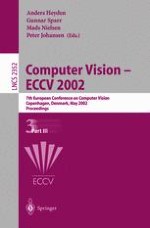2002 | OriginalPaper | Buchkapitel
A Framework for High-Level Feedback to Adaptive, Per-Pixel, Mixture-of-Gaussian Background Models
verfasst von : Michael Harville
Erschienen in: Computer Vision — ECCV 2002
Verlag: Springer Berlin Heidelberg
Enthalten in: Professional Book Archive
Aktivieren Sie unsere intelligente Suche, um passende Fachinhalte oder Patente zu finden.
Wählen Sie Textabschnitte aus um mit Künstlicher Intelligenz passenden Patente zu finden. powered by
Markieren Sie Textabschnitte, um KI-gestützt weitere passende Inhalte zu finden. powered by
Time-Adaptive, Per-Pixel Mixtures Of Gaussians (TAPP-MOGs) have recently become a popular choice for robust modeling and removal of complex and changing backgrounds at the pixel level. However, TAPPMOG-based methods cannot easily be made to model dynamic backgrounds with highly complex appearance, or to adapt promptly to sudden “uninteresting” scene changes such as the repositioning of a static object or the turning on of a light, without further undermining their ability to segment foreground objects, such as people, where they occlude the background for too long. To alleviate tradeoffs such as these, and, more broadly, to allow TAPPMOG segmentation results to be tailored to the specific needs of an application, we introduce a general framework for guiding pixel-level TAPPMOG evolution with feedback from “high-level” modules. Each such module can use pixel-wise maps of positive and negative feedback to attempt to impress upon the TAPPMOG some definition of foreground that is best expressed through “higher-level” primitives such as image region properties or semantics of objects and events. By pooling the foreground error corrections of many high-level modules into a shared, pixel-level TAPPMOG model in this way, we improve the quality of the foreground segmentation and the performance of all modules that make use of it. We show an example of using this framework with a TAPPMOG method and high-level modules that all rely on dense depth data from a stereo camera.
